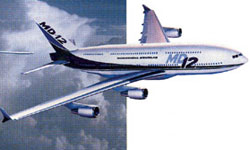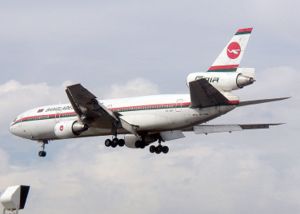PlaneSpottingWorld welcomes all new members! Please gives your ideas at the Terminal.
McDonnell Douglas
Template:Infobox Defunct Company
McDonnell Douglas was a major American aerospace manufacturer and defense contractor, producing a number of famous commercial and military aircraft. It merged with Boeing in 1997 to form The Boeing Company.
Contents
Background
The company was founded from the firms of James Smith McDonnell and Donald Wills Douglas. Both men were of Scottish ancestry, graduates of MIT and had worked for the aircraft manufacturer Glenn L. Martin Company. Douglas had been chief engineer at Martin before leaving to establish Davis-Douglas Company in early 1920 in Los Angeles. He bought out his backer and renamed the firm the Douglas Aircraft Company in 1921.
McDonnell founded J.S. McDonnell & Associates in Milwaukee, Wisconsin in 1928. His idea was to produce a personal aircraft for family use. The economic depression from 1929 ruined his ideas and the company collapsed. He went to work for Glenn L. Martin. He left in 1938 to try again with his own firm, McDonnell Aircraft Corporation, this time based near St. Louis, Missouri.
World War II was a major earner for Douglas. The company produced almost 30,000 aircraft from 1942 to 1945 and the workforce swelled to 160,000. Both companies suffered at the end of hostilities, facing an end of government orders and a surplus of aircraft. Both heavily cut their work forces.
After the war, Douglas continued to develop new aircraft, including the DC-6 (1946) and the DC-7 (1953). The company moved into jet propulsion, producing their first for the military - the conventional F3D Skyknight in 1948 and then the more 'jet age' F4D Skyray in 1951. Douglas also made commercial jets, producing the DC-8 in 1958 to compete with the Boeing 707. McDonnell was also developing jets, but being smaller they were prepared to be more radical, building on their successful FH-1 Phantom to become a major supplier to the Navy with the F2H Banshee, F3H Demon, and the F-101 Voodoo. The advent of the Korean War helped push McDonnell into a major military fighter supply role, especially with the noted F-4 Phantom II (1958).
Both companies were eager to enter the new missile business, Douglas moving from producing air-to-air rockets and missiles to entire missile systems under the 1956 Nike program and becoming the main contractor of the Skybolt ALBM program and the Thor ballistic missile program. McDonnell made a number of missiles, including the unusual ADM-20 Quail, as well as experimenting with hypersonic flight, research that enabled them to gain a substantial share of the NASA projects Mercury and Gemini. Douglas also gained contracts from NASA, notably for part of the enormous Saturn V rocket. Both companies were now major employers, but both were having problems.
Douglas was strained by the cost of the DC-8 and DC-9, and the companies began to sound each other out about a merger. Inquiries began in 1963; Douglas offered bid invitations from December 1966 and accepted that of McDonnell. The two firms were officially merged on April 28, 1967 as the McDonnell Douglas Corporation (MDC).
History
In 1967, with the merger of McDonnell and Douglas Aircraft, Dave Lewis, then president of McDonnell, was named chairman of what was called the Long Beach, Douglas Aircraft Division. At the time of the merger, Douglas Aircraft was estimated to be less than a year from bankruptcy. Flush with orders, the DC-8 and DC-9 aircraft were 9 to 18 months behind schedule, incurring stiff penalties from the airlines. Mr. Lewis was active in DC-10 sales in an intense competition with the Lockheed L-1011. In two years, Mr. Lewis had the operation back on track and in positive cash flow. He returned to the company's St. Louis headquarters where he continued sales efforts on the DC-10 and managed the company as a whole as President and Chief Operating Officer through 1971.
The DC-10 began production in 1968 with the first deliveries in 1971. In 1977, the next generation of DC-9 variants, dubbed the "Super 80" (later renamed the MD-80) Series, was launched. This proved to be a very successful program. The next aircraft to be launched was the MD-11, an improved, upgraded version of DC-10. To date, the MD-11 remains the only modern trijet. After its launch in 1986, the MD-11 sold 200 units, but was discontinued in 2001 after the merger with Boeing as it competed with the Boeing 777. McDonnell Douglas's final commercial aircraft was launched in 1988. The MD-90 was a stretched version of the MD-80, equipped with International Aero Engines V2500 turbofans, the largest rear-mounted engines ever on a commercial jet. The MD-95, a modern regional aircraft closely resembling the DC-9-30, was the last McDonnell Douglas designed commercial jet produced.
Several artists impressions exist of an aircraft named the "DC-10 Twin" or DC-X which McDonnell Douglas considered in the early 1970s but never built. This would have been an early twinjet with a striking likeness to the Airbus A300 and similar performance characteristics, which was never progressed to a prototype. It could be argued that this was a major mistake on the part of McDonnell Douglas as it would have given them an early lead in the huge twinjet market that subsequently developed, as well as commonality with much of the DC-10's systems and engineering. Poor airline acceptance was cited at the time for not proceeding.[citation needed]
The KC-10 was the second consecutive McDonnell Douglas transport aircraft to be selected by the US Air Force in 1976. The first was the C-9 Nightingale. However, the buy of both aircraft was curtailed by the end of the Cold War. This curtailment combined with the loss of both the Advanced Tactical Fighter and Joint Strike Fighter contracts hurt McDonnell Douglas.
Through the years, McDonnell Douglas also produced many successful military aircraft, including the F-15 Eagle (1974) and the F/A-18 Hornet (1975) as well as the Harpoon and Tomahawk missiles. The oil crisis of the 1970s was a serious shock to the commercial aviation industry and McDonnell Douglas was forced to contract heavily and also began to diversify to reduce the impact of potential future downturns.
In 1984, McDonnell Douglas expanded into helicopters by purchasing Hughes Helicopters from the Summa Corporation. McDonnell-Douglas paid $500 million for the company, which renamed the McDonnell Douglas Helicopter Company. This became McDonnell Douglas Helicopter Systems in 1985. McDonnell Douglas Helicopters most successful product was the Hughes' designed AH-64 Apache attack helicopter.
On January 13, 1988, McDonnell Douglas and General Dynamics won the US Navy Advanced Tactical Aircraft (ATA) contract. The 4.83 billion US dollar contract was to develop the A-12 Avenger II, a stealthy, carrier based, long range flying wing attack aircraft that would replace the A-6 Intruder. Technical issues, over 2 billion dollars in development cost overruns, growing unit costs, and continuous delays led to the termination of the program on January 13, 1991 by then Defense Secretary Dick Cheney. A decade of litigation would proceed over the contract termination: the government claimed that the contractors had defaulted on the contract and were not entitled to a final 1.3 billion dollars in progress payments while McDonnell Douglas and General Dynamics believed that the contract was terminated out of convenience and thus the money was owed. As of 2007, the case continues to sit in litigation.[1] The chaos and financial stress created by the collapse of the A-12 program led to the layoff of 5,600 employees.[2] The advanced tactical aircraft role vacated by the A-12 debacle would be filled by another McDonnell Douglas program, the F/A-18E/F Super Hornet.

In 1992, McDonnell Douglas bravely unveiled a study of a double deck jumbo-sized aircraft designated MD-12 that is similar to the present day Airbus A380. Despite briefly exciting the market, the study was perceived as merely a public relations exercise to disguise the fact that MDC was struggling under intense pressure from Boeing and Airbus. It was clear to most in the industry that MDC had neither the resources nor the money to develop such a monstrous aircraft, and the study quickly sank without trace. A similar double deck concept was used in Boeing's later Ultra-Large Aircraft study intended to replace the 747, but ultimately the double deck concept would not see the light of day until the Airbus A380.
Following Boeing's 1996 acquisition of Rockwell's North American division, McDonnell Douglas merged with Boeing in 1997 in a US$13 billion stock-swap to create The Boeing Company.
Products
Military airplanes
- F-4 Phantom II (started under McDonnell Aircraft)
- F-15 Eagle
- AV-8 Harrier II (in partnership with British Aerospace)
- F/A-18 Hornet
- T-45 Goshawk jet trainer (in partnership with British Aerospace)
- C-17 Globemaster III (Design and early production)
Commercial airplanes

- DC-9 (started under Douglas Aircraft)
- DC-10 (with cockpit upgrade designated MD-10)
- MD-11 (stretched and modernized version of the DC-10)
- MD-80 Series (stretched and modernized version of the DC-9)
- MD-90 (stretched and modernized version of the MD-80)
- MD-95 (latest evolution of the DC-9, sold as Boeing 717)
Helicopters
- AH-64 Apache (started under Hughes Helicopters)
- MD 500 series (started under Hughes Helicopters)
- MD 600
- MD Explorer
Other
- Tomahawk missile
- Harpoon missile
- Skylab space station
References
- ↑ A-12 Avenger II. GlobalSecurity.org.As of March 16, 2007, the case is still in litigation with the 2001 court ruling vacated by the Federal Court of Appeals in 2003. For more details on the litigation, please read the account by GlobalSecurity.org.
- ↑ "McDonnell Air gets president". New York Times (03-08-1991).
- Greider, William (1997). One World, Ready or Not. Penguin Press. ISBN 0-7139-9211-5.
External links
Lists relating to aviation | |
|---|---|
| General | Timeline of aviation · Aircraft · Aircraft manufacturers · Aircraft engines · Aircraft engine manufacturers · Airports · Airlines |
| Military | Air forces · Aircraft weapons · Missiles · Unmanned aerial vehicles (UAVs) · Experimental aircraft |
| Notable incidents and accidents | Military aviation · Airliners · General aviation · Famous aviation-related deaths |
| Records | Flight airspeed record · Flight distance record · Flight altitude record · Flight endurance record · Most produced aircraft |
| This article is licensed under the GNU Free Documentation License. It uses material from the Wikipedia article "McDonnell Douglas". |
- Pages with broken file links
- Articles with unsourced statements since January 2008
- All articles with unsourced statements
- Companies based in St. Louis
- History of Long Beach, California
- Defense companies of the United States
- Aerospace companies of the United States
- Companies established in 1967
- 1997 disestablishments
- McDonnell Douglas
- Boeing mergers and acquisitions
- Articles sourced originally from Wikipedia
